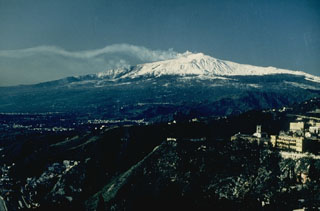Report on Etna (Italy) — 12 February-18 February 2025
Smithsonian Institution / US Geological Survey
Weekly Volcanic Activity Report, 12 February-18 February 2025
Managing Editor: Sally Sennert.
Please cite this report as:
Global Volcanism Program, 2025. Report on Etna (Italy) (Sennert, S, ed.). Weekly Volcanic Activity Report, 12 February-18 February 2025. Smithsonian Institution and US Geological Survey.
Etna
Italy
37.748°N, 14.999°E; summit elev. 3357 m
All times are local (unless otherwise noted)
Sezione di Catania - Osservatorio Etneo (INGV) reported that the new eruption that began at Etna on 6 February continued during 10-16 February. Activity observed through webcams and during daily field inspections was characterized by the effusion of a lava flow from a fissure and explosive activity at the summit. The lava flow from the fissure that opened at the base of Bocca Nuova Crater on 8 February continued to effuse lava. The lava flow advanced down the SW flank, descending to 2,150 elevation by 11 February and 1,960 elevation by 13 February. The distal end of the flow was 6-8 m thick. Photogrammetric data collected by drones on 14 and 16 February, combined with satellite data, showed that the lava flow advanced 380 m during that 48-hour period. The total flow length was 4.2 km and covered an estimated area of 0.3 square kilometers (300,000 square meters). There were reports of phreatic explosions from the interaction with lava and snow that ejected lava fragments a few hundred meters, particularly on 12 February.
Explosive activity at SE Crater originated from at least two vents based on webcam views and a 12 February field inspection. During the field inspection weak explosive activity originated from a vent located between SE Crater and Bocca Nuova Crater. Minor ash emissions rose from SE Crater and quickly dissipated downwind, depositing ash near the summit. Ash emissions intensified on 12, 14, and 16 February; the Aviation Color Code was raised to Red (the highest level on a four-color scale) on 12 February then back to Orange on 13 February, to Red on 14 February and back to Orange that same day, again to Red on 16 February, and back to orange on 18 February. Although weather conditions sometimes obscured views, the ash emissions rose no higher than an estimated maximum altitude of 5.5 km a.s.l. (about 2.1 km above the summit). According to a news report flights in and out of the Catania-Fontanarossa Airport were disrupted during 12-17 February.
Geological Summary. Mount Etna, towering above Catania on the island of Sicily, has one of the world's longest documented records of volcanism, dating back to 1500 BCE. Historical lava flows of basaltic composition cover much of the surface of this massive volcano, whose edifice is the highest and most voluminous in Italy. The Mongibello stratovolcano, truncated by several small calderas, was constructed during the late Pleistocene and Holocene over an older shield volcano. The most prominent morphological feature of Etna is the Valle del Bove, a 5 x 10 km caldera open to the east. Two styles of eruptive activity typically occur, sometimes simultaneously. Persistent explosive eruptions, sometimes with minor lava emissions, take place from one or more summit craters. Flank vents, typically with higher effusion rates, are less frequently active and originate from fissures that open progressively downward from near the summit (usually accompanied by Strombolian eruptions at the upper end). Cinder cones are commonly constructed over the vents of lower-flank lava flows. Lava flows extend to the foot of the volcano on all sides and have reached the sea over a broad area on the SE flank.
Sources: Sezione di Catania - Osservatorio Etneo (INGV), Euronews

